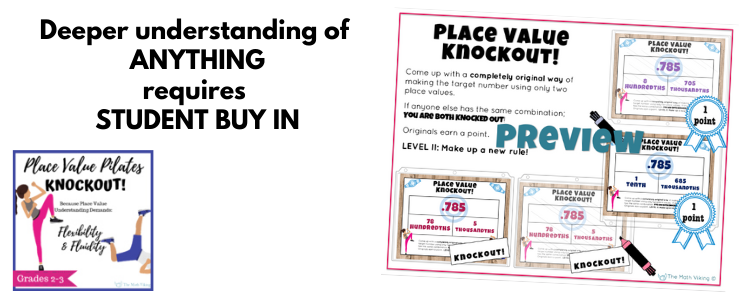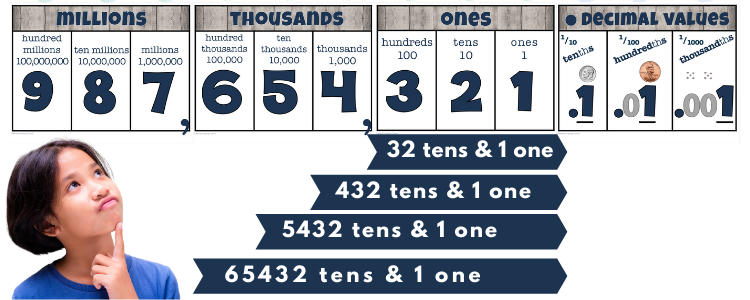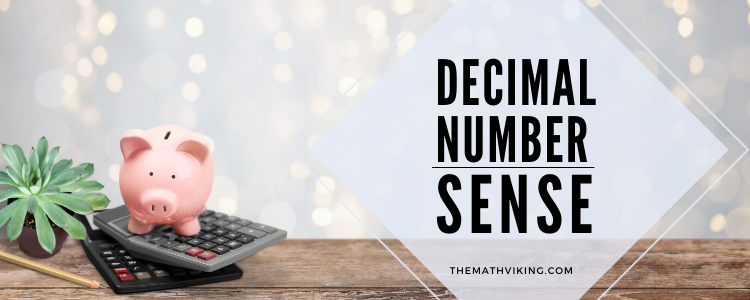
How well do your students understand decimal numbers? Can they decompose them based on their place values? Do they estimate them confidently?
SPOILER ALERT: They can.
You already work SO DAMN HARD to identify and rectify misconceptions. Well, one of the most common misconceptions that we teachers have, is the idea that most of us “just don’t think that way” and it is unreasonable to expect children to do so.
Nope. They absolutely can. But only if we truly believe. Do you? Are you even a little open to the idea? Because I believe that developing number sense with decimal numbers is one of the most important tasks placed on upper elementary teachers. It is also one of the most elusive.
Decimal Number Sense Really is a Thing!
Developing deeper place value understanding is worth those last morsels of energy and shreds of sanity. Don’t believe me?
What if I promised that we could connect our decimal number sense activities to the most basic addition and multiplication concepts and the most sophisticated fraction ideas all at the same time; would that help? What if I suggested that we could go back to first grade counting circles and number charts and the most rudimentary part whole models?! Because we can! And we should.
*For an overview of essential place value components, please consider this post.
What is it about UNITS?
Here is a quick check for true place value understanding:
“How many tenths in all of the number 17.5? Would you like me to rephrase that? How many tenths would it take to make 17.5 without any ones or tens.”
If students, or teachers, do not answer in the same amount of time it would take to tell how many hundreds in 1,370, then more time is needed to develop the idea. Period.
There is no shame in thinking carefully about it. Thinking is always good. Consider, however; that if number sense is composed of number knowledge and number strategy, then both must grow in tandem. Too much of one without the other will cause an imbalance. Imbalance causes weakness. We don’t have to be perfect. But why wouldn’t we aim for balance?
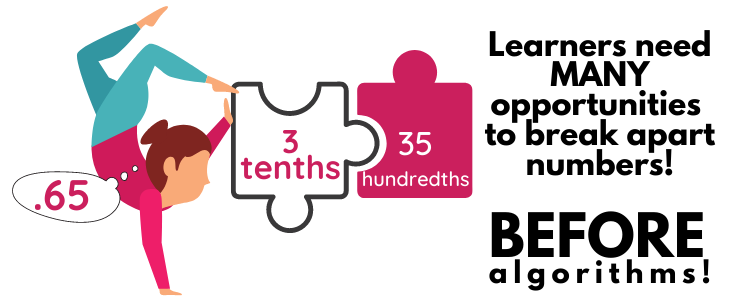
(Click here to see Decimal Place Value Matching Tasks)
When teachers ask me how to move away from traditional textbook teaching, my first suggestion is always to START the unit without the book. Typically, teachers feel more comfortable straying from the book AFTER they have done a majority of the lessons. I totally get it! But…
Consider that sense making skills are best developed when we NEED to figure something out. If we take away that need by explicitly sharing procedures, we can’t get it back. It’s over. Gone.
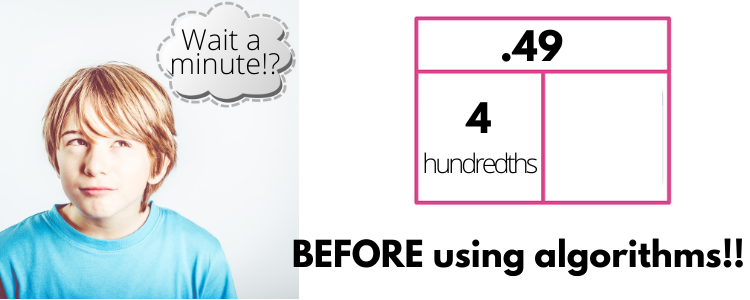
Now, this doesn’t mean we should give up. But I promise, if you give these sense making ideas a chance FIRST next time, it is mind blowing! Offering a simple task like this without explicit instruction makes it more like a puzzle kids want to solve.
Still, consider incorporating them during decimal instruction this year wherever you are now, and revisit later. Many students will forget how to think once they become proficient compute-ers. ((sigh))
The part whole tasks, challenge learners to decompose numbers before learning anything about adding and subtracting decimals. Students must rely on place value understanding.
In my experience, using blank hundred charts (think: hundredth chart!) and part whole models prime students for success with decimals on number lines. I also love the way these tools connect our learning about decimal numbers to the way we learned about whole numbers.

(Click here to see Part Whole Model Decimal Tasks)
What is missing in Place Value Instruction?
So. Many. Things.
What I feel is globally lacking in place value with decimal numbers, is using the most familiar constructs; number charts, part whole models, counting, comparing, building and deconstructing; to build number sense.
The academic disconnect from grades K-2 and grades 3-5 is overwhelming. When we can bridge this gap, we will all be bette for it. I have found ways of bringing algebra into kindergarten and kindergarten into fifth grade on a daily basis. What I have that upper elementary teachers do not have, is simply: access.

Here is an example of using a familiar construct to build place value understanding and number sense. (Click here to see Part Whole Model Decimal Tasks)
Incorporate these sense making routines into your instruction, wherever you can! But please try to BEGIN with them next time. Expect some struggle. Embrace the struggle. Remember that struggle builds strength and it is SOOOO worth it.
- Introduce decimal numbers with counting circles. Personally, I do a super quick count by hundreds, tens, and ones and then ask my students, “According to the pattern, what will we count by next?” Even in fourth grade, there is always one who says “tenths” or “decimals”. I use a blank number chart and manipulatives while we count – there is a full lesson and more ideas in the Decimal Task Resource.
- Use actual place value manipulatives and play money in part whole models to compose and decompose numbers.
- Make decimal numbers out of manipulatives, words, money and fractions at the same time. Compare and discuss.
- Examine decimals on number lines as the infinite quantities between all other whole numbers.
- Play lots of games writing numbers as “fraction numbers, decimal numbers and word numbers”
- Explore which fraction numbers can easily be written as decimals and which cannot and um..why is that?
- Compare decimal fraction number properties to whole number properties. Yes, there are still fact families! Yes, there are still commutative, associative and distributive properties!
- Explore computation mentally before algorithms! ALWAYS PLAY FIRST, because it’s not exploring if we already learned about it. Change some of your own tried and true games to work with decimal numbers. Try Hit the Button Number Bonds with decimal numbers, Greg Tang Place Value and expanded form place value. Find all of my favorites under the decimal tile on the GAME GRID.
- Compose and decompose decimals using part whole models and number lines right away! When you get to the addition/subtraction lessons, you will be miles ahead. DOUBLE YOUR EFFORTS: Skip count by 3 tenths or 6 hundredths etc… before you get to decimal multiplication as well. Remember how I suggested that we could combine decimal sense making with simple multiplication fact practice? Here is our chance!
- Never forget. Daily Number Reasoning Templates make it easy to develop the big ideas all year long.
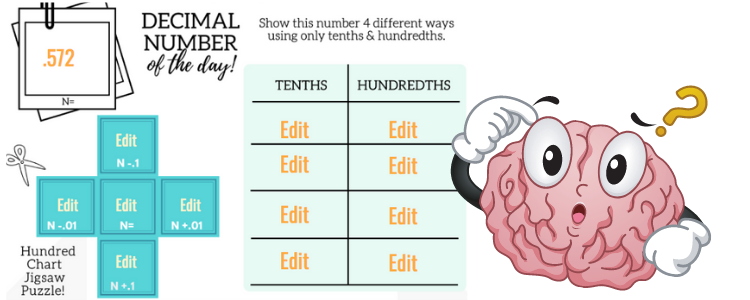
Here is an example of using familiar constructs to build number sense and place value understanding. (Click here to see digital & printable Daily Number Reasoning Templates)
Looking for More Engaging Resources?
Place Value Knockout is HANDS DOWN my favorite place value game for the biggest and littlest numbers. 🙂 The kids love it and it really shows where kids are. I have opened with this in fifth grade and it gave me more data than any beginning of the year test. I grouped my kids and realized who didn’t need any place value lessons! That made my lesson launch smaller, and gave me more time with my struggling learners.
Whenever I can find an engaging game with a low floor and high ceiling, that helps me move advanced learners on, I prefer to open with it. I have always found this easy to do with fractions, but never with place value. Until now.
(Click here for the Place Value Chart Board Topper above)
Beat The Teacher Freebie for Small Group Games
Since I am really a game based and inquiry based teacher, most of my interventions and small group tasks are game-i-fied. This is a simple game I use whenever I don’t have anything better, or kids simply need more repetition to build their confidence.
This works with any idea that you can use patterns to develop. (um ..okay.. most things) It is a fabulous way to build confidence with old ideas AND it is a great way for kids to make predictions about brand new ideas!!
More about this in the next blog post! But why not start using this free template today!
Beat the Teacher Template!
Would you like to teach place value with Knockout Games? Beat the Teacher? and interactive games? After twenty years of teaching math, I firmly believe that developing big ideas requires engagement and buy in. Good games fill those needs.
Do you have any other go-to’s for building place value number sense? I would love to hear from you! Share a comment below or meet me on Facebook– where there is another great digital and printable freebie available for download called “Place Value Fugitives”.
Join me as we explore the big ideas in elementary mathematics.


